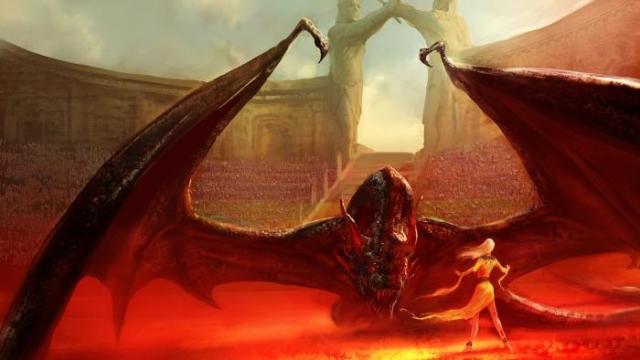The monsters in George R.R. Martin’s Game of Thrones are magically badass. But could dragons, direwolves and lizard-lions be scientifically plausible, on some level? Today we’re going to try to answer that question — with the help of some biology experts.
Picture: Marc Simonetti
We’ll explore the hypothetical anatomy, ecology and behaviour of the iconic fantasy creatures of Westeros and Essos, and ultimately, try to draw some conclusions about whether these creatures could exist in our (albeit, less magical) world.
Dragons
Dragons are arguably the most iconic fantasy beasts of the Game of Thrones series, and a great place to begin our biological exploration. As we all know, dragons are massive, flying, carnivorous reptiles with no natural predators. They possess an awesome and terrible power, the capability of laying waste to armies and cities alike with their fiery breath.

Thousands of years before the events of the series, the dragons of Martin’s universe were discovered lairing in the Fourteen Flames, a massive chain of volcanoes that extends across the Valyrian peninsula. It was the sheep-herding folk of Valyria who first learned to master and ride dragons, using the beasts to forge an vast empire that stretched across the continent of Essos.
Centruies later, an apocalyptic eruption killed most of the world’s dragons and laid waste to the Valyrian empire. Only a handful of dragons, those in the care the Targaryens, survived. At the present day in the series, the species is believed extinct, with the exception of Danaerys Targaryen’s dragons.
“Old Valyria.” Picture: Ted Nasmith
When dragons disappeared from the world, most knowledge of their biology was lost, so we’ll have to fill in the gaps with comparative anatomy and a healthy dose of speculation.
Could A Dragon Actually Fly?
The dragons of Game of Thrones have long, sinuous bodies with snake-like tails, two short back legs and large front wings, similar to those of a bat. They’re heavily armoured in thick black scales, which presumably protect them against the molten magma showers of their fiery homeland.
It’s unclear just how large the dragons of ancient times were, but they could live for upwards of two centuries, and, like many reptiles, never stopped growing throughout their lifetimes. If the truck-sized skull Arya discovers in Season 1 in the dungeons of King’s Landing is any indicator, we can be quite sure the dragons of ancient Valyria were larger than any animals that ever took to the skies of Earth.
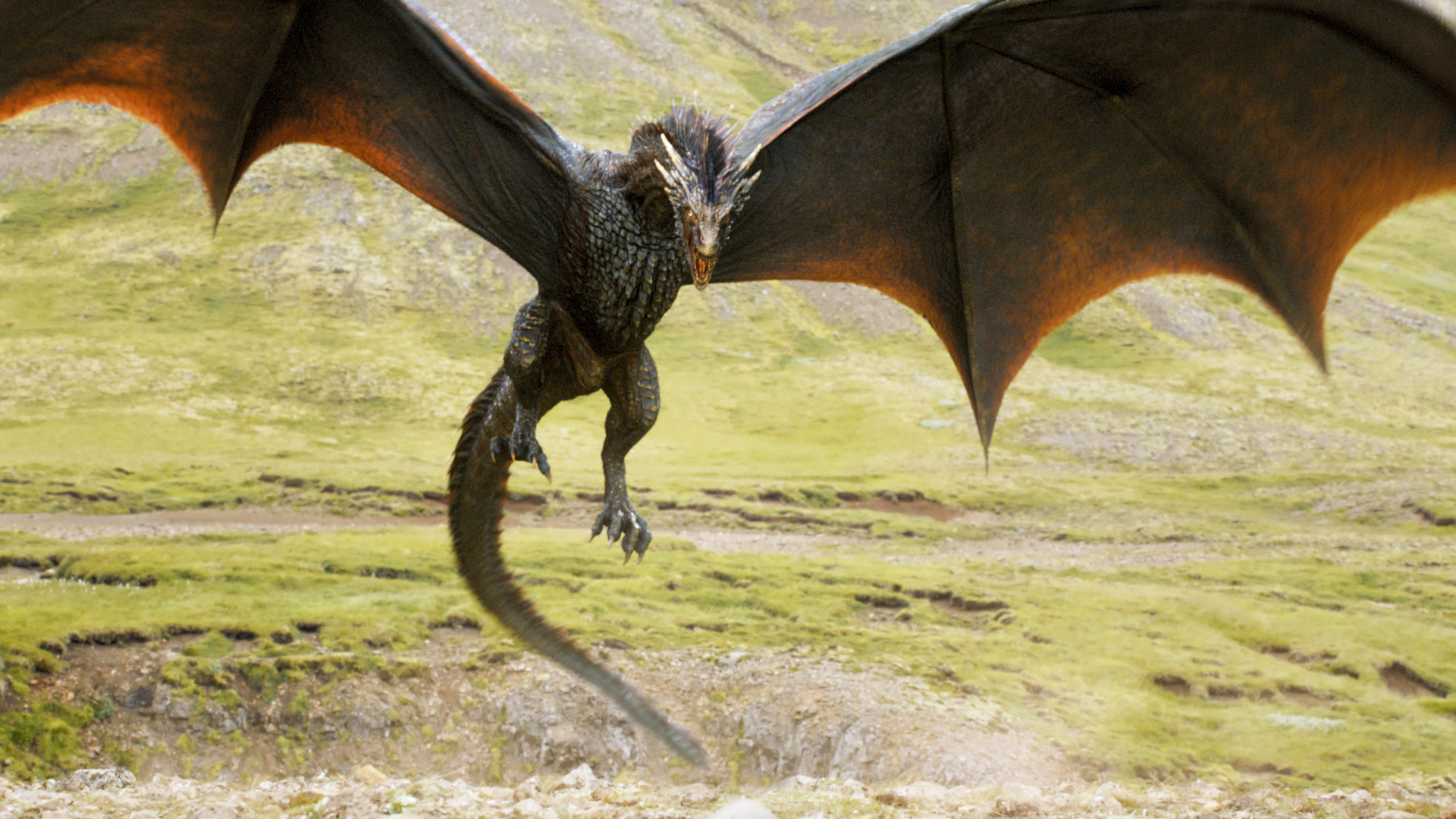
Which brings us to the Big Science Question: Could a creature so massive ever actually become airborne? To find out, I spoke with paleontologist Mark Witton, an expert on the largest flying animals that ever did exist on Earth — pterosaurs.
Pterosaurs were bird-like, carnivorous reptiles that roamed the skies during the time of the dinosaurs, from the late Triassic to the end Cretacous. The largest known pterosaurs, the azhdarchids, died out 66 million years ago, in the same mass extinction event that spelled doom for the dinosaurs. Based on the fossil record, these animals achieved wingspans of over 9m and weighed upwards of 227kg.
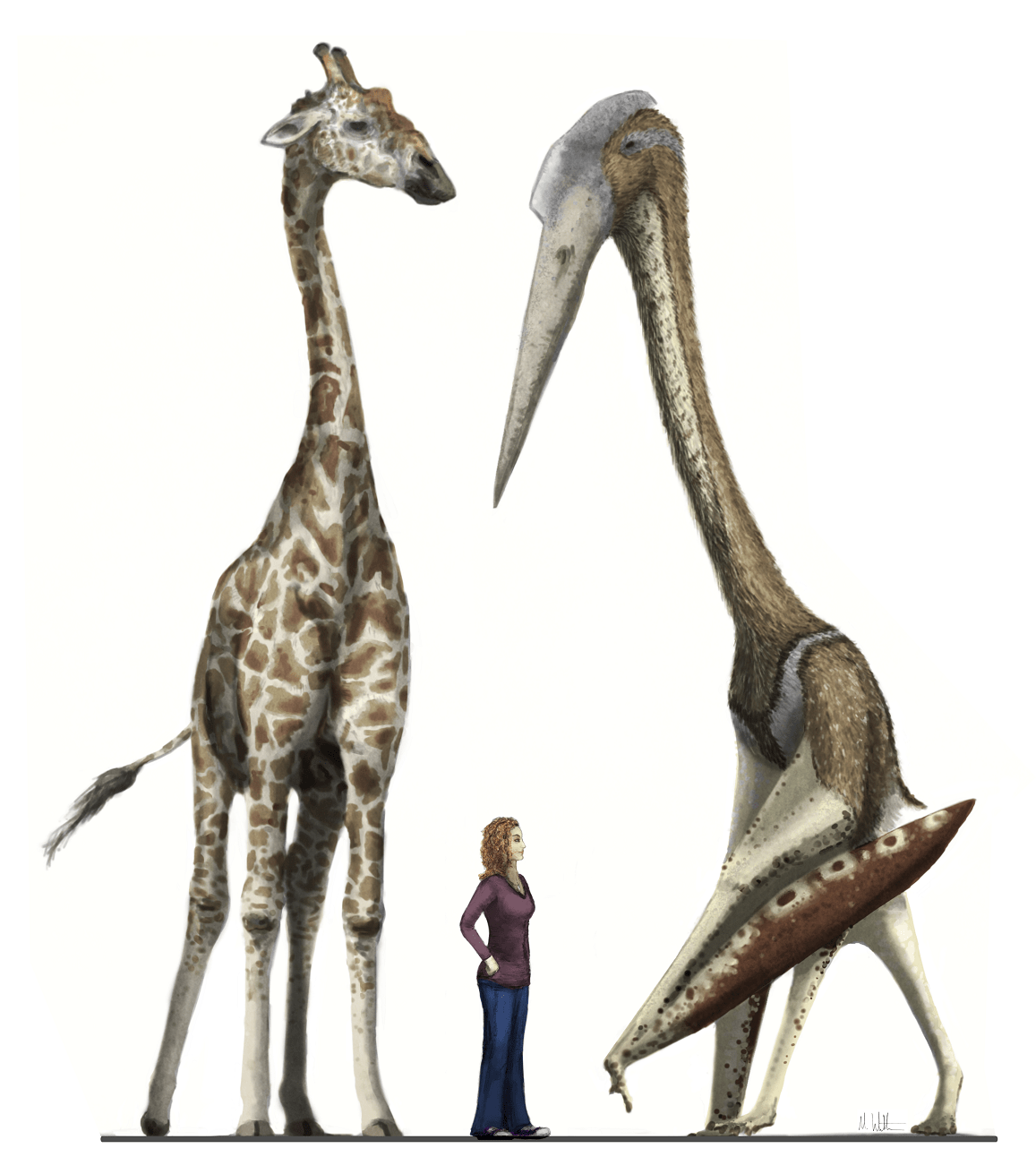
The giant pterosaur, Arambourgiania, compared for size against a giraffe and a human. Picture: Mark Witton
How could such a large animal have possibly gotten itself off the ground? First and foremost, pterosaurs needed to be as light as physically possible. Like their avian counterparts, these animals possessed extremely light bones, in some cases no more than a 2-3 millimetre hollow tube. For additional buoyancy, they had large air sacs dispersed around their muscles and throughout their body.
“These adaptations were critical,” Witton said. “While a giraffe may weigh a ton or two, a pterosaur of the same size would only weigh as much as a large pig. For dragons to be flight-worthy, they’d almost certainly have to have hollow bones, as well.”
The meat that a pterosaur did put on was very carefully distributed.”The biggest pterosaurs were essentially a fairly small body wrapped in loads of concentrated muscle,” Witton said. “As you move away from the animal’s core, their limbs become spindly very quickly.”
As it happens, that’s actually not too different from the body plan we see in the Game of Thrones dragons — at least, in the adolescents we watch flying about in Seasons 3 and 4. “What’s really cool about the dragons in Game of Thrones is they have got these big, deep chests, and as you move away from the body, the wings and arms get proportionally quite thin,” Witton said. “That’s actually pretty accurate. If I were designing a dragon for flight, I’d go for a similar body plan.”
The big thing weighing Daenerys’s dragons down is probably their tails. “We know that early pterosaurs had fairly long tails,” said Witton. “But they were very slender and whiplike. When I look at that dragon tail, that looks more like something a croc would possess, which is fine for ground movement, but probably a bit too massive for flight.”
If a dragon was to get that hefty tail off the ground, it’d need to expend precious energy doing so. Which brings us to another major consideration: To sustain its active, rampaging lifestyle, a dragon is going to need a lot of calories.
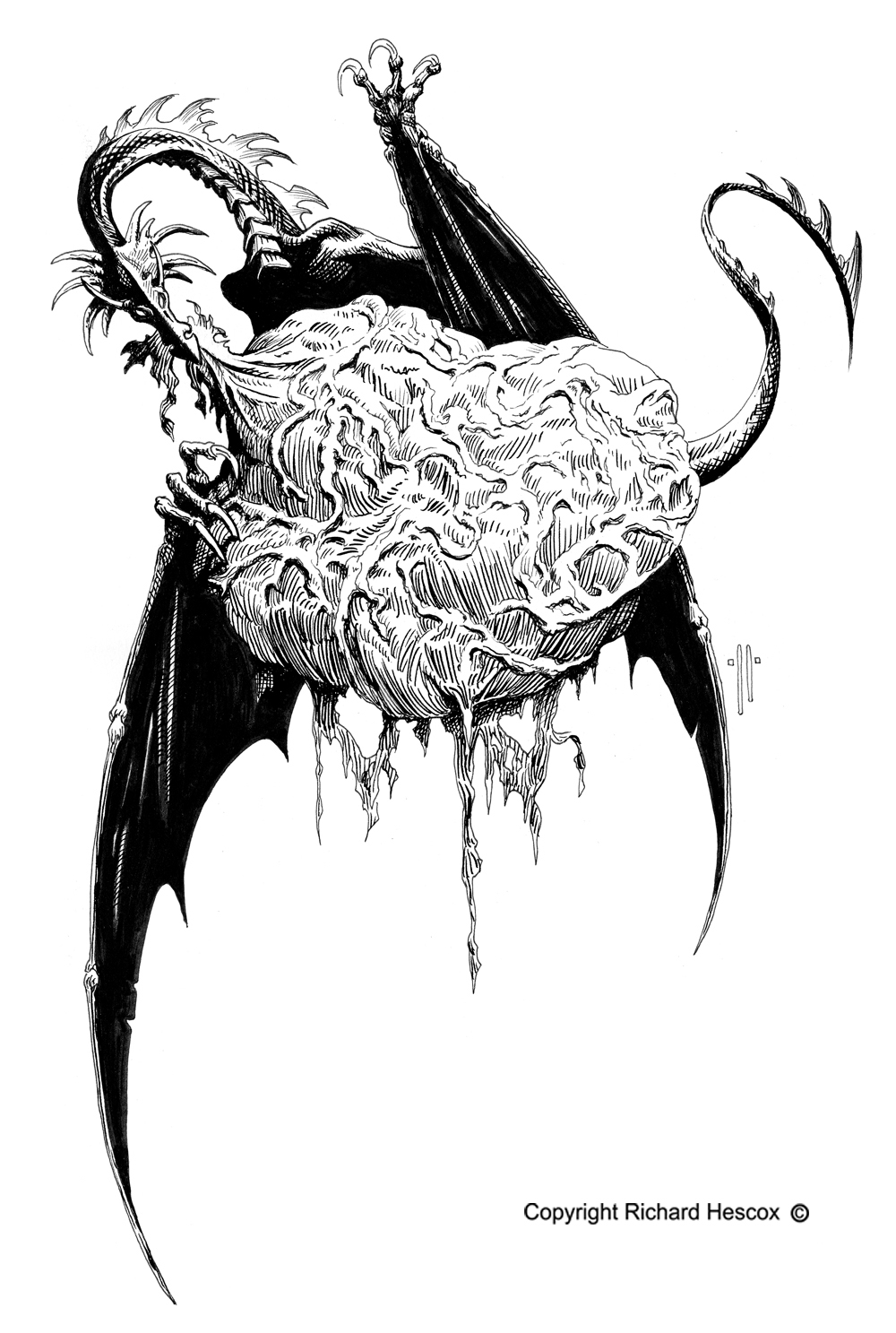
Picture: Richard Hescox. Find more of his art on Facebook
Fortunately, we know that dragons aren’t particularly picky about what they eat, and that hunting and killing prey poses about as much challenge as microwaving a hot pocket. But how many calories would a dragon have to eat to spend all day pillaging cities from the air?
I decided to do a back-of-the-envelope calculation. According to freedieting.com, a 180cm tall, 90kg man who works a physical labour job needs to consume approximately 3600 calories per day to maintain his weight. Let’s just make a number of unfounded assumptions and say that this man’s lifestyle and physiology is comparable to that of a dragon’s. A 900kg, adolescent dragon, then, would need to consume roughly 36,000 calories per day. According to Calorie King, 450g of beef flank contains on average 880 calories. So, our mid-sized dragon would need to eat roughly 19kg of steak a day to maintain its weight.
Which doesn’t actually sound too crazy. If we’re conservative and double that amount, a single human could still offer several days worth of sustenance. But would a dragon’s post-lunch human food-baby bog it down for the rest of the afternoon? Perhaps. “Some scavenging birds gorge themselves and struggle to take off afterwards,” Witton said. “Pterosaurs too might have gotten themselves into situations where they needed to work that food through before takeoff.”
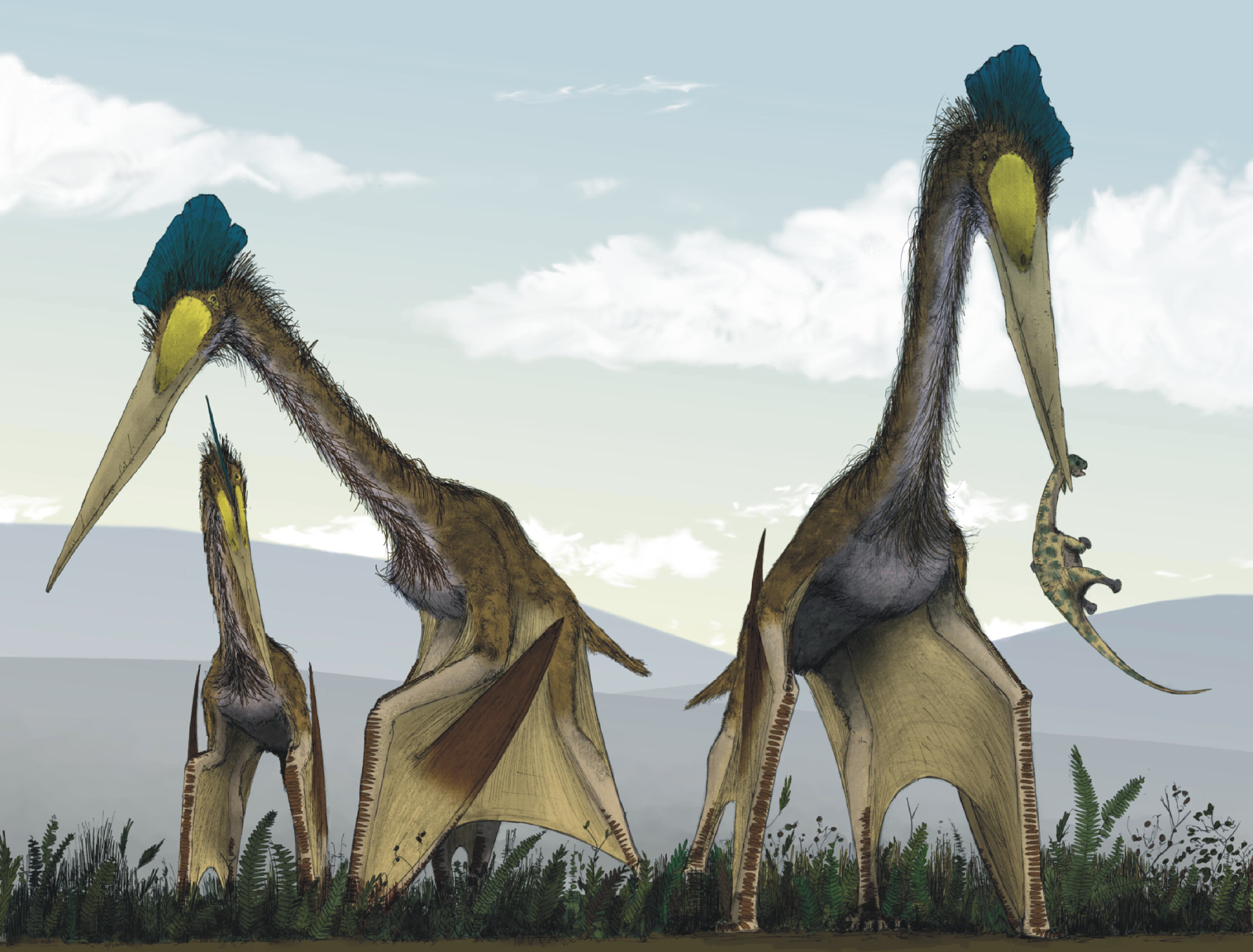
A group of giant azhdarchids foraging on a Cretaceous fern prairie, one with a juvenile titanosaur in its beak. Image credit: Mark Witton.
Still, Witton says, based on their size and the mechanical stress their bones can handle, it’s not inconceivable that 227kg pterosaurs might have eaten 36kg meals and still taken to the sky, albeit with some struggle. Which puts a dragon eating a human and continuing on its merry way totally within the realm of the physically possible.
And lest we forget, dragons have one ability that’s giving them a big leg up when it comes to energy: Fire. “You need to be warm bodied to fly,” Witton said. “If you’re an insect, you power up in the sun, if you’re a bird or a bat, you generate your own heat and use a furry coat to keep yourself insulated. We assume pterosaurs were similar to birds and mammals in this respect.”
While for non-magical beings, maintaining core heat means burning calories, if we concede dragons this one otherworldly gift, then the animals have a self-replenishing source of heat that comes at no additional cost. “It would certainly help solve the problem of food,” Witton said. “If there’s a way they can keep warm without burning extra calories, it’s possible dragons could have proportionally lower caloric intake than a bird or a mammal.”
Who knows, maybe fire-breath would even free up enough energy to make that hefty tail manageable.
A Predator To Rule The World
As massive, obligate carnivores with no natural enemies, dragons are almost certainly the apex predator in their environment. Which might very well be the entire Game of Thrones world, if we again look to pterosaurs — whose fossils are found nearly everywhere on Earth — for a range comparison.
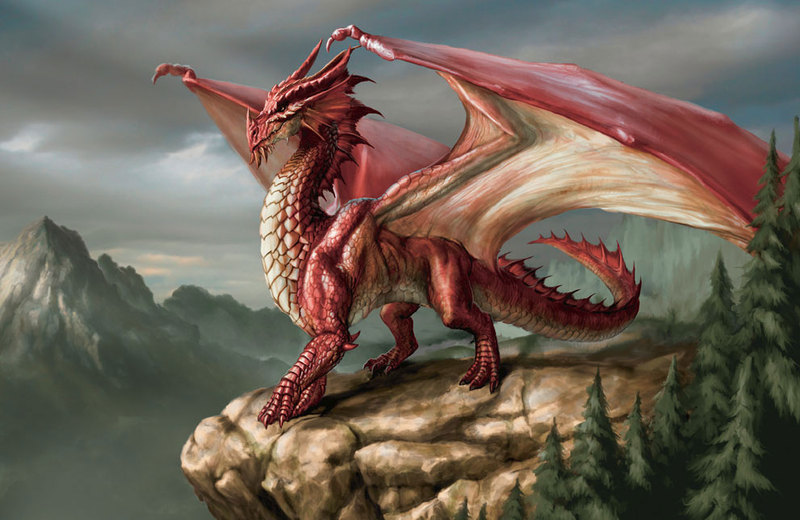
Picture: Aggiorna, via Wikimedia Commons
“A giant pterosaur could take off from England, fly over the Eastern US, most of the way inland, and back to the UK in a single journey,” Witton told me. “Now, that would be an extreme flight, and it would be very thin afterwards, but the fact is, we’re talking animals that could cover thousands of miles, at top speeds of close to a hundred miles per hour.” Whoa.
“If you translate that to Game of Thrones dragons, you’ve got to assume they could have hunted all over Westeros,” he continued. “The narrow sea is an afternoon trip, and as they get bigger they’re just going to be moving faster.”
Many top predators today also cover massive ranges. Take the Siberian tiger, whose hunting grounds typically span hundreds of miles, or the great white shark, which has been reported to swim from South Africa to Australia and back in a single year. Rare as these apex hunters may be, scientists now know they can have a profound influence on their environment. By keeping smaller populations of carnivores and herbivores in check, predators exert a top-down control that ripples throughout the entire structure of their ecosystem, indirectly influencing everything down to the amount of plant biomass and the incidence of infectious disease.
As larger, hungrier, and more destructive apex predators than anything on Earth, we can almost view dragon attacks as a sort of natural disaster — one that hammers ecosystems when it hits, but happens infrequently enough that populations have ample time to recover between attacks. We’ve got no way of knowing how different things were when dragons ruled the skies of Westeros and Essos, but given their size, range, and sheer might, it seems fair to assume they were probably the dominant ecological force the world over.
Direwolves
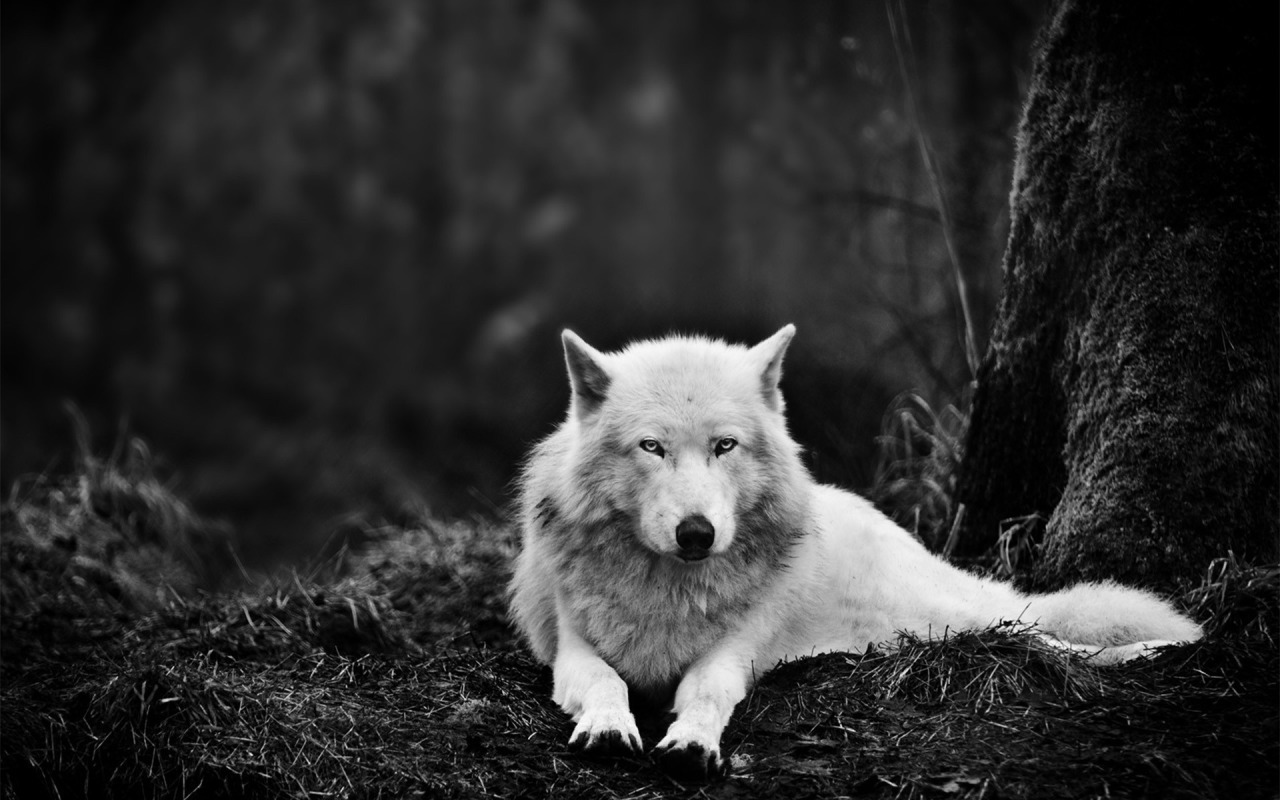
Ghost, Jon Snow’s direwolf companion
The Direwolf, sigil of House Stark, may be a more loyal companion than a dragon, but it’s an equally vicious killer when the need arises. Direwolves once claimed a vast swath of the North as their home, but past human hunting drove these animals out of all but the coldest refuges. Today, they still roam the forests and tundra lands north of The Wall, and are occasionally sighted by men of the Night’s Watch. Direwolves are highly social and hierarchical pack hunters, but if adopted at a young age, they can become fiercely devoted to a human master, as well.
Is A Direwolf A Dire Wolf?
Unlike dragons, direwolves seem to be directly inspired by a once-living creature. The dire wolf, Canus dirus, was a top predator across most of North and South America during the Pleistocene, until it disappeared along with many of Earth’s megafauna species some 12,000 years ago. To find out how George R.R. Martin’s direwolf compares to its Earthly counterpart, I spoke with Robert Dundas, a paleoecologist who has been studying the creatures for decades.
As you might expect, there were some striking differences.

Picture: Richard Hescox. Find more of his art on Facebook
Direwolves in Game of Thrones are basically a jacked-up version of grey wolves, with several key anatomical differences. They have got larger heads, a leaner, more pronounced muzzle, longer legs in proportion to their bodies, and massive, razor sharp teeth. An adult direwolf can get as large as a small horse and easily tear a man’s arm from its socket.
When I described the Westerosian direwolf to Dundas, he started to laugh. “People have this image of dire wolves as being these massive creatures,” he said. “But in terms of overall body size and proportions, they’re actually pretty similar to a timber wolf or grey wolf.”
The major anatomical difference, Dundas said, has to do with bulk rather than size. “When you reconstruct the dire wolf’s musculature based on its bone structure, you end up with a much huskier wolf,” he said. What’s more, dire wolves of the Pleistocene actually had slightly shorter limbs than grey wolves, making their bodies less suited for high-speed chases.
Smaller than their Westerosian counterparts they may be, the hunting skills of Pleistocene dire wolves are legendary. As pack hunters, they were probably able to tackle some of the largest prey around, including giant North American ground sloths, camels, horses, and perhaps even young mammoths and mastodons. In South America, they ate an entirely different set of large herbivores. Which brings us to another difference between the Stark children’s direwolves and the Pleistocene variety: Their habitat.
“Dire wolves lived in a wide range of environments,” Dundas said. “We find them in open grasslands, closed forests, and from sea level up to 8000 feet (2438m) in elevation or more.” The only place dire wolves were not to be found? The far north. Their northernmost fossil bones hail from southern Alberta, which roughly coincides with the border of the Laurentide ice sheet.
“There is no evidence that dire wolves existed in glacial environments,” Dundas said.”We’re not really sure what to make of this northern range limitation, given that they’re pretty well-adapted to live in just about any sort of environment.”
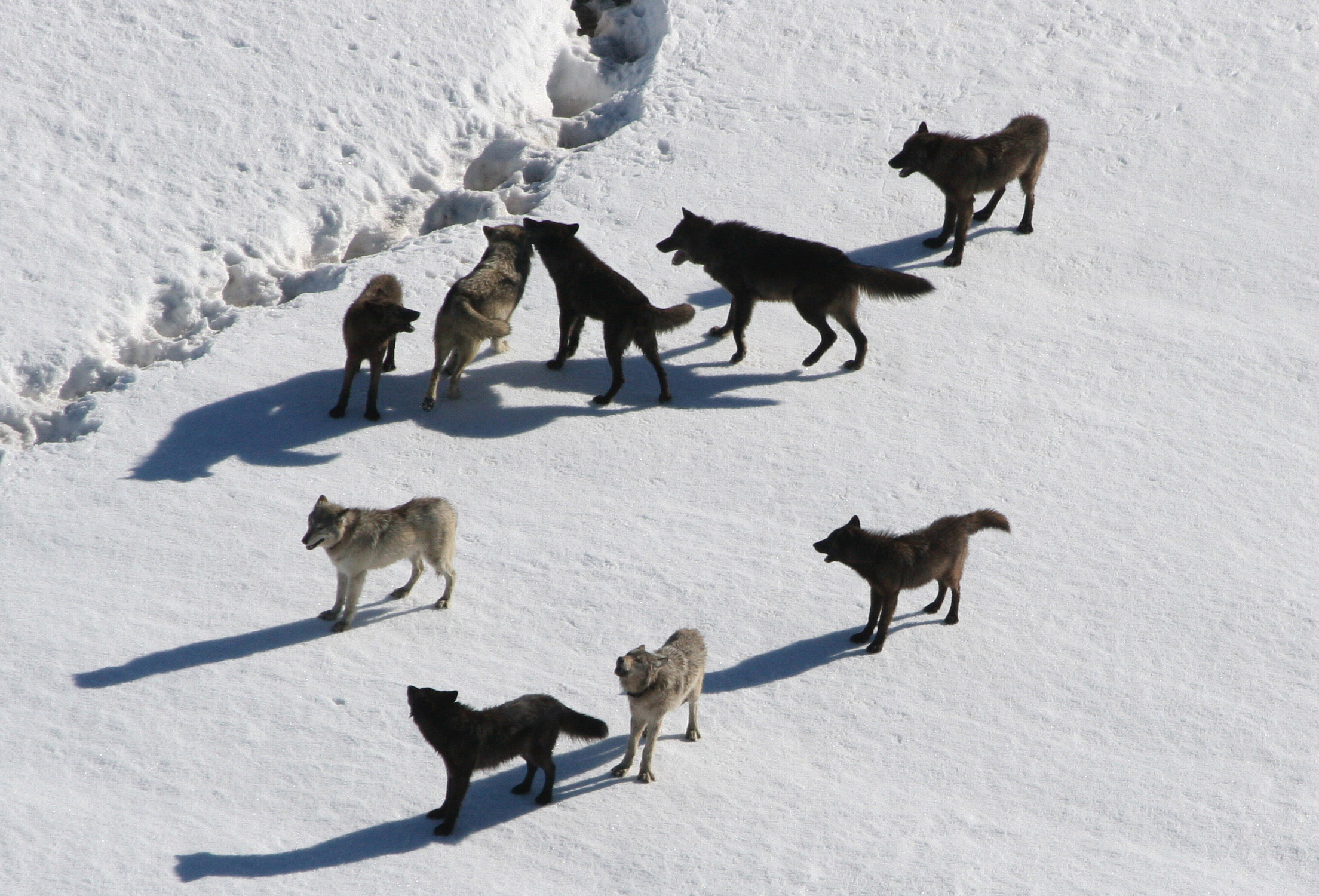
A pack of grey wolves on a snowy landscape. Picture: Wikimedia
On the other hand, we do have records of grey wolves in Alaska, during the Pleistocene and today. And it so happens that at the northern extent of their range, grey wolves can get pretty darn massive. “It’s common for body size to increase when you get into very cold environments,” Dundas said. “We’ve seen grey wolves in Alaska and Siberia that are larger than any dire wolf skeletons.”
As to the question of whether a dire wolf could have been tamed? “We’ve got no evidence for domestication,” Dundas said. “We know that dire wolves co-occurred with humans, so it’s a fascinating question what it would have been like to have a run-in with one.” (Probably, terrifying.)
All of which is to say, Westerosian direwolves sound a lot more like very large grey wolves of Siberia and Alaska than their Pleistocene namesake. While the decision cast grey wolves on screen might have been one of necessity, oddly enough, it may also make the most scientific sense.
Manticores (Spoiler Alert For This Section)
In Game of Thrones, death can come in all shapes and sizes. One of my favourite underrated creatures of this world is the manticore, a scorpion-like arthropod that hails from remote tropical islands in the Jade Sea, thousands of miles east of Westeros. Manticores are prized by men for their venom, a small dose of which is more than enough to stop a grown man’s heart. Before Ser Gregor Clegane crushes Oberyn Martell’s head at the end of Season 4, Martell manages to stab him with a manticore venom-coated spear, leaving the massive knight on the brink of death.
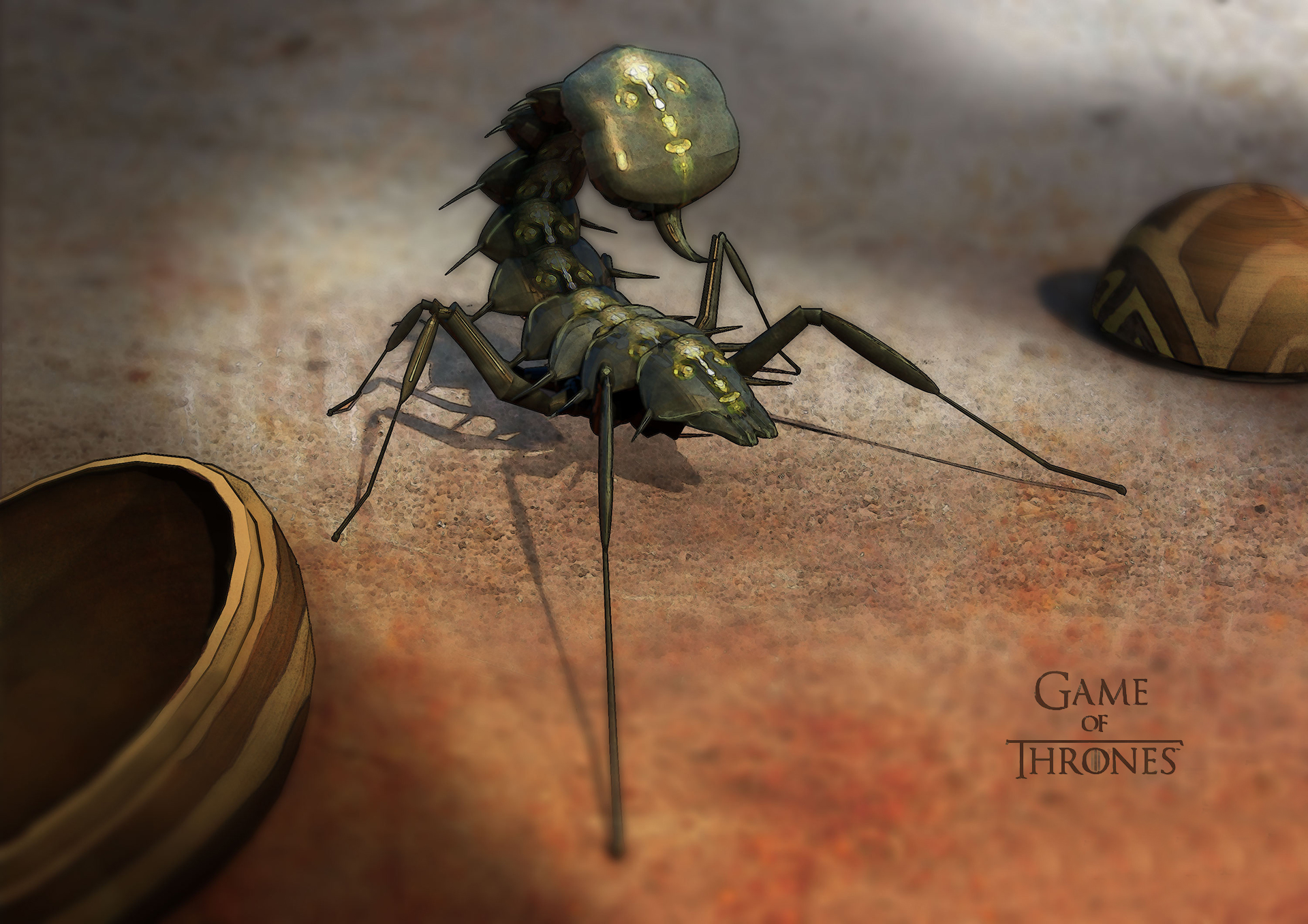
Artist’s rendition of a manticore. Reproduced with permission of concept artist Max Berman and HBO.
Long before manticores became the tool of assassins and alchemists the world over, they lived out their lives in distant jungles, feasting on smaller prey and growing to the size of a lobster. To learn what their lives might be like I spoke to Lorenzo Prendini, a scorpion biologist at the American Museum of Natural History in New York.
The Largest Scorpions In The World
Their are nearly 2000 described species of scorpions, found in virtually every terrestrial environment with the exception of cold boreal ecosystems and tundra. But based on the manticore’s size and habitat, there are only a few possible Earthly comparisons.
“The closest thing you’re going to get in the real world is either the emperor scorpion in tropical West Africa, or the giant forest scorpions in Southeast Asia and India,” he said.
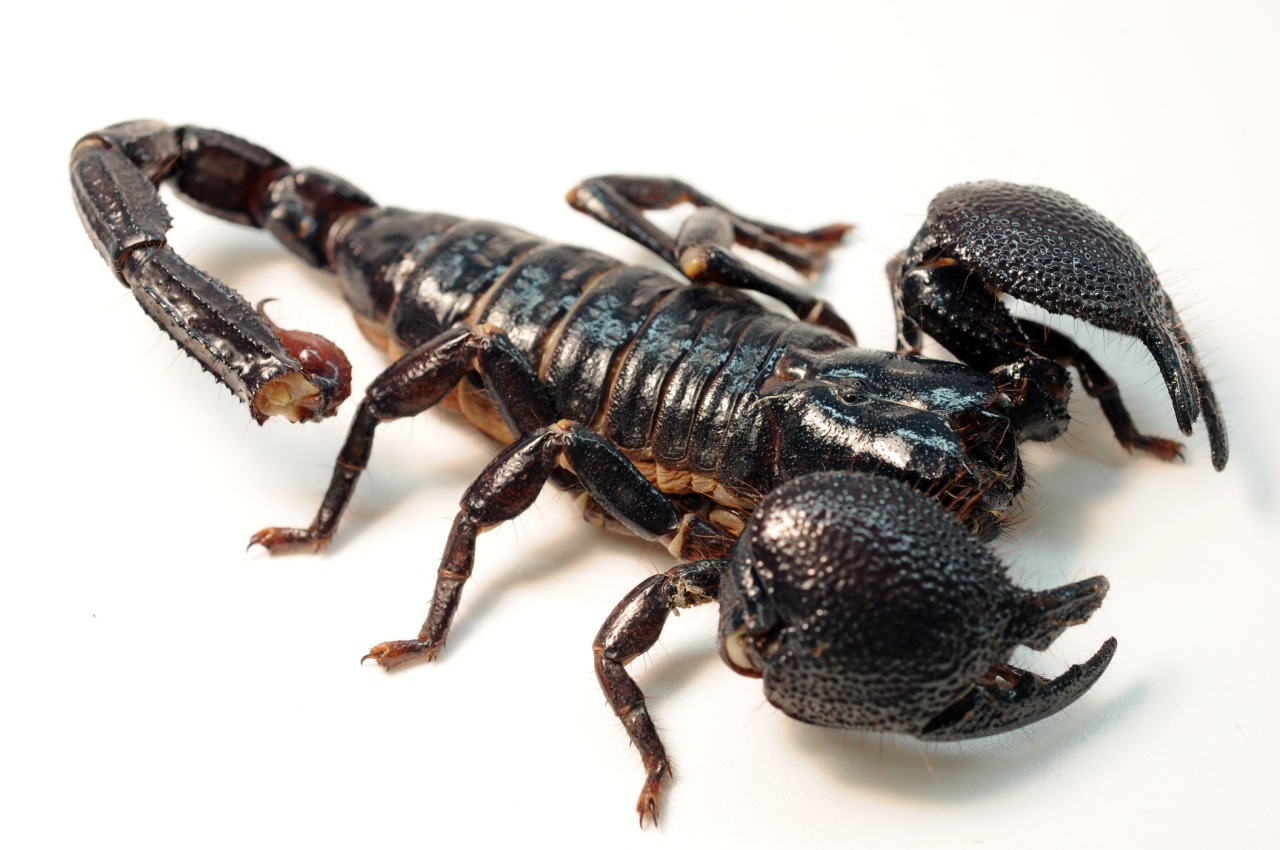
The emperor scorpion, one of the largest scorpions on the planet. Picture: Wikimedia
The emperor scorpion, Pandinus imperator, and the giant forest scorpions belonging to the genus Heterometrus, are among the largest predatory arthropods in the world, with adults averaging 8-9 inches in length. Compared with most other arthropods, these scorpions are distinctly K-selected organisms, meaning they have traded abundant offspring for smaller population sizes and longer lives. A brood of baby emperor scorpions typically consists of 20 to 30 individuals, and females invest an unusual amount of time and energy caring for their young. Emperors and giant forest scorpions alike take many molts to reach sexual maturity, and can live upwards of thirty years.
Unlike their desert counterparts, for tropical scorpions, high humidity is an absolute requirement. They retain moisture through their heavy, wax-coated battle armour, and by spending nearly all of their time in underground burrows, coming out only at night to snag prey, which consists of anything from small insects to rodents to lizards.
“These guys are extremely sensitive to their prey,” Prendini told me. “They can detect the subtle air current changes and the vibrations of insects half a meter away. When they sense prey they dash out of their burrow lightning speed, grab the animal and pull it back as quick as they can.”
In many ways, the lives of manticores are probably similar to other tropical scorpions. But there’s one key difference between manticores and their terrestrial cousins that suggests a dramatic evolutionary divergence: Their choice of weapon.
“On the whole, tropical scorpions don’t really rely on venom because they have such powerful claws,” Prendini told me. “Typically they will grab their prey and just start ripping it apart. Venom is costly, so they don’t waste it.”
When tropical scorpions do resort to venom, it’s usually to paralyse feisty prey before they dismember it, or in defence against another predator (mongooses, owls, and certain lizards will go after tropical scorpions, which, according to Prendini, are “a great source of protein.”) But their venom is by no means deadly.
“It’s pretty similar to a bee or a wasp sting,” Prendini said. “It will hurt quite a bit, but it won’t kill you.”
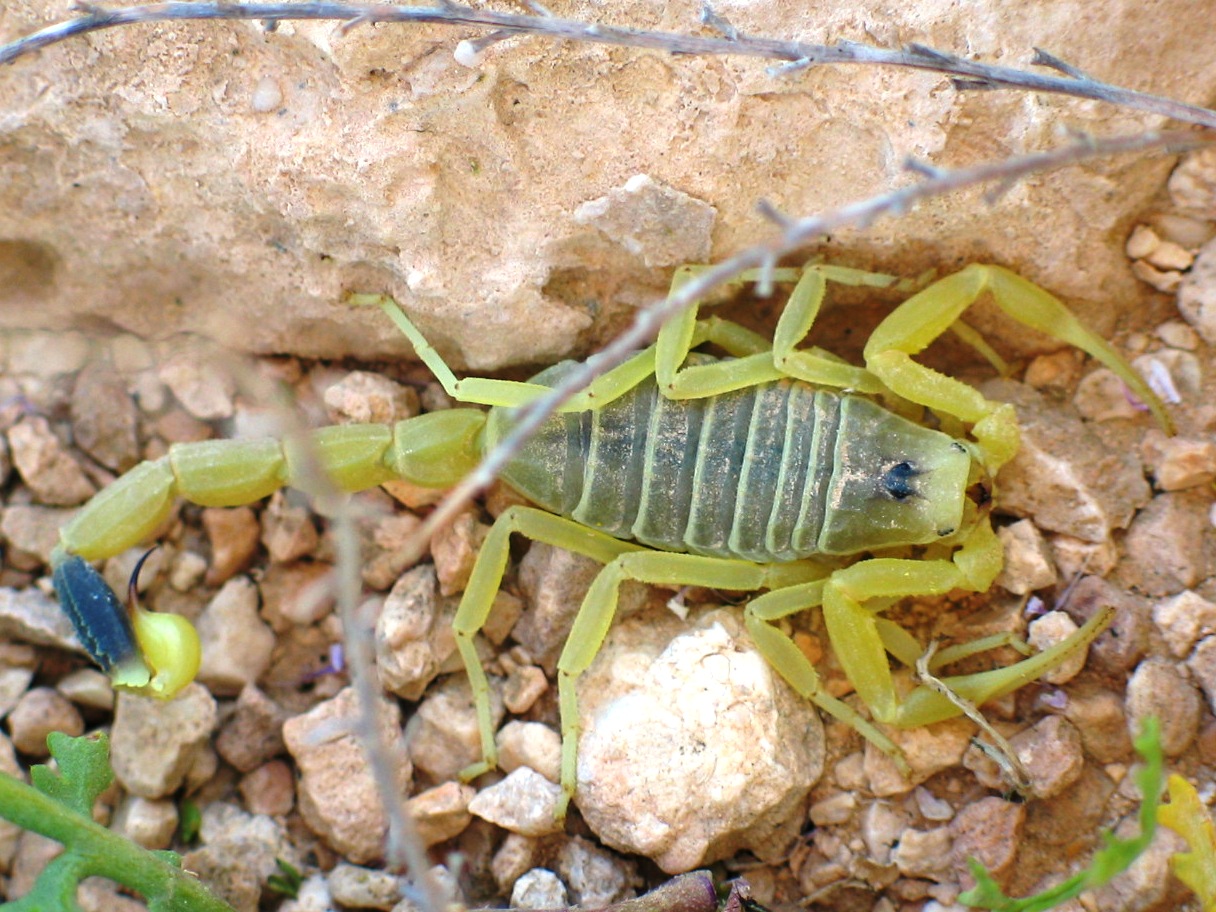
The Deathstalker, one of the most venomous scorpions in the world. Image Credit: Wikimedia
Manticores, on the other hand, don’t appear to possess fighting claws at all, so we’ve got to assume venom is their primary weapon, both for defence and hunting. This makes the manticore a bit of an outlier among scorpions: Typically, as size increases, we see these creatures trade venom for muscle.
Indeed, the most toxic scorpions in the world are all rather puny. The Indian red scorpion, whose sting can send an adult human into cardiac arrest, tops at at about 3.5 inches length, while the Deathstalker, whose extraordinary painful venom is also a potent neurotoxin, rarely exceeds 2 inches.
Still, toxicity doesn’t necessarily relate to size — it’s a function of the many selective pressures of an organism’s natural environment. Perhaps the manticore has experienced a lot of predation, and found venom to be a more effective deterrent than big, meaty claws. Or maybe manticores are locked in an toxic evolutionary arms race with competing species. The Jade Islands could be filled with venomous creatures, and the battle for resources and territory could well depend on whoever has the highest poison threshold.
We can’t know for sure without more information, but whatever circumstances have caused such a potent fighter to thrive, it’s clear that these remote islands are worthy of a scientific expedition.
Lizard Lions
They don’t get as nearly as much attention as dragons, but there’s another fearsomely large reptilian predator lurking about the backwaters of Westeros: The Lizard-Lion, sigil of House Reed. As far as we know, lizard-lions are found only in the bogs and swamps of The Neck, the region that divides The North from the rest of The Seven Kingdoms.

Picture: Game of Thrones Wiki (Would like a better one!)
Lizard-lions are crocodilian animals, and from the sparse descriptions found in the books, behave much like their real-world counterparts, lying still like floating logs in the water, waiting to ambush their prey. They’re said to grow to the size of lions and viciously attack unwary men wandering through the marshes. Here’s one of the few descriptions of their habitat, pulled from A Song of Ice and Fires:
Sansa shuddered. They had been twelve days crossing the Neck, rumbling down a crooked causeway through an endless black bog, and she hated every moment of it. The air had been damp and clammy….dense thickets of half drowned trees pressed close around them, branches dripping with the curtains of pale fungus. Huge flowers bloomed in the mud and floated on pools of stagnant water, but if you were stupid enough to leave the causeway and pluck them, there were quicksands waiting to suck you down, and snakes watching from the trees, and lizard-lions floating half submerged beneath the water, like black logs with eyes and teeth.
The Westerosian Alligators?
Based on descriptions in the books, these massive lizards probably fall within the order Crocodilia, the taxonomic group comprising crocs, alligators and caimans. On Earth, these large, predatory, semiaquatic reptiles are solitary hunters who spend most of time sedentary, but are capable of swimming quickly and even galloping over land for short bursts to catch their prey.
Their northerly habitat leads me to suspect lizard-lions are the Westerosian alligators. There are two extant species of alligators in the real world: The American alligator, found across the Southern United states and reaching weights of over 450kg, and the Chinese alligator, a highly endangered and much smaller species found only in the Yangtze river in China.
Both species are substantially more cold-tolerant than crocodiles, which are restricted to tropical regions of South America, West Africa, Asia and Australia. Indeed, in The World of Ice and Fire, George R.R. Martin’s comprehensive history of the Seven Kingdoms, we learn that there are crocodiles in Sothoryos, the southernmost continent in the known world.

The saltwater crocodile, the largest living crocodilian in the world, maxing out at 2000kg. Picture: Mike / Flickr
As for their famed aggression in the series, it’s true that crocs and gators do sometimes attack humans. But such incidents are rare.
“A croc or gator might attack you if you come to the waters edge and effectively act like their prey does, but you don’t seem them going around hunting down people,” said Emma
Schachner, a vertebrate physiologist and alligator expert at Louisiana State University. “Usually, they’re pretty low key.”
And if raised in captivity, crocodilians can be downright tame. Who knows, maybe some brave men and women of the North tried to cajole the beasts into battle once upon a time, or hitch a ride through the swamps of the Neck on their scaly backs. Then again, if you fell off a lizard-lion’s back and got trapped in The Neck’s treacherous quicksand, it was probably game over.
Krakens
Krakens are massive sea monsters that are said to skulk the depths of oceans worldwide. Like lizard-lions, there’s scant information to be found on these beasts in either the books or the TV series, although based on the limited descriptions at our disposal, we can be fairly sure they’re cephalopods:
“Kraken: strong, as long as they’re in the sea. When you take them out of the water, no bones. They collapse under their proud weight, and slump into a heap of nothing. You’d think they’d know that.”
-Ramsay Snow , A Song of Ice and Fire
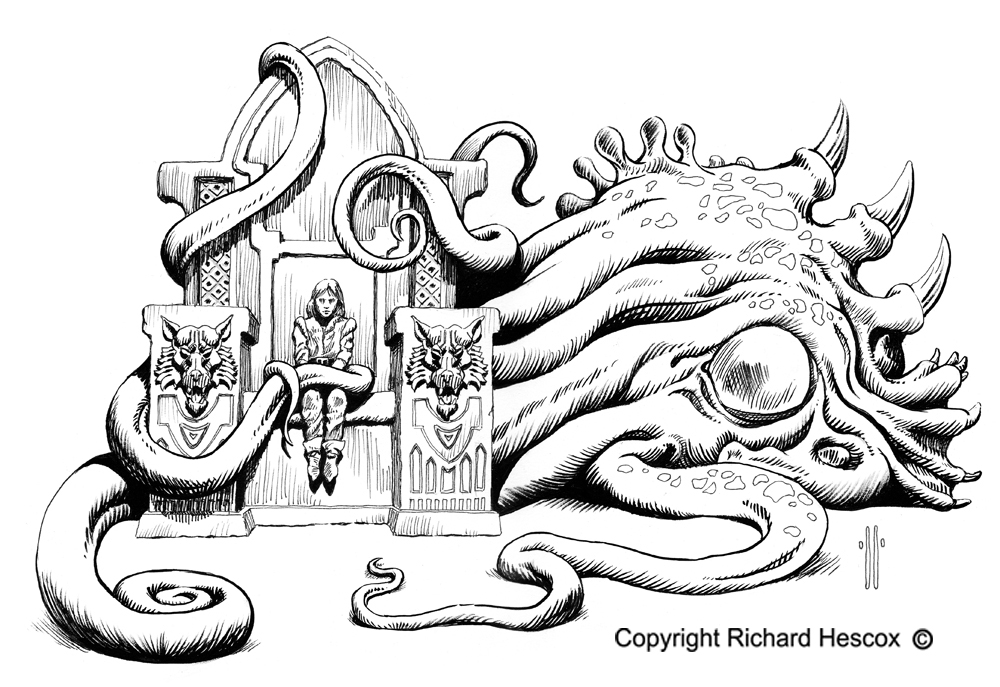
Picture: Richard Hescox. Find more of his art on Facebook.
The largest cephalopod on Earth — the giant squid — was also the stuff of legend far before humans ever confirmed its existence. Indeed, descriptions of a tentacled sea monster trace back can be found in the 13th century Icelandic saga Örvar-Oddr and the Norweigan scientific work Konungs skuggsjá. While a kraken-like creature continued to feature prominently in Scandanavian folklore until the 20th century, the first clear photograph of a live giant squid wasn’t captured until 2002.
The reason giant squids — and probably, the krakens of Game of Thrones — have remained so elusive has to do with their habitat. Giant squids are thought to inhabit every ocean on Earth, but only at depths below 300m. What’s more, given their truly massive size — an adult male can reach lengths of up to 13m — it’s likely giant squid populations are naturally quite small. Like giant squids, krakens probably live in perpetual darkness, hunting all sorts of small fish and marine invertebrates, and knowing no natural enemies save the occasional toothed whale.
The one scientific issue I take with Krakens is their rumoured aggression toward humans. Krakens are said to viciously attack ships, and it’s even suggested that the scent of human blood draws them up from the depths of the ocean. If this were true, then Krakens would either have to have a fantastic sense of smell, or live much closer to the surface than we imagined. Given that most deep sea creatures won’t survive depressurisation, my money would be on the latter.
But again, these are unconfirmed rumours. If our world is any indicator, it will be many centuries yet before the people of Westeros and Essos can say for sure whether Krakens are anything more than the stuff of saltwater legend.
White Walkers
We can’t talk about the strange creatures of Westeros without mentioning White Walkers, the ice-blooded, humanoid race from the time of the First Men.
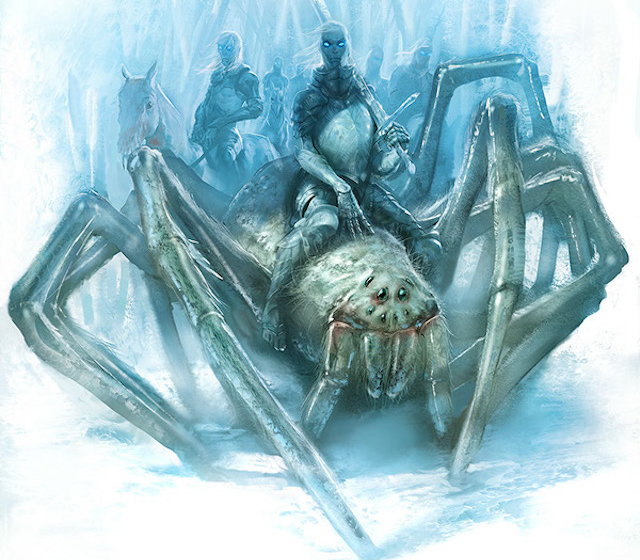
Also known as the Others, White Walkers first appeared roughly 8,000 years before present-day in the series, descending from their arctic homelands during a brutally long winter called the Long Night. They’re described in the books as tall, gaunt, pale humanoids, with cold blue eyes as bright as stars. During their southward march, the White Walkers killed everything in their path without mercy or reason, reanimating human corpses as wights to march in their frozen army. Eventually, the people of Westeros rallied together against the man-slaughterers, driving them all the way back to the far north, and erecting The Wall to keep them locked away forever.
White Walkers possess superhuman strength, can freeze anything they touch, and are thought to bring cold weather in their wake. Rather than just mindless killing machines, they seem to be an intelligent, if blood-lusty, humanoid species with a complex social structure, language, and stone-age technology. Could they, too, have a place in our world?
Sadly, I think the answer here has to be a resounding no. Even if we give White Walkers their ability to rise the dead and their immunity to everything but dragonglass, we can’t get around the fact that biochemistry as we know it doesn’t work when you’re frozen. Now, there are a few extreme microorganisms that can survive in subzero temperatures for long periods of time, by desiccating their cells into spores and shutting down all metabolic processes. Other microbes, and some plants, are able to continue metabolising at subzero, by maintaining high cellular salt concentrations and lowering their internal freezing point.
But the idea of being metabolically active while actually frozen is pretty much incompatible with life as we know it — it’s sort of like asking whether your body could still function if you suddenly became a gas. Every single biochemical process, from building new proteins to replicating DNA to firing neurons, is based on the transport of molecules within a liquid media.
Sorry guys, but I think they’re just magical zombies.
After surveying just a few of the most fearsome beasts of Game of Thrones, it’s hard to draw any overarching conclusions about the feasibility of their fantastical lives. Direwolves and lizard-lions seem like plausible creatures by Earthly standards, while dragons have some physiological issues, although if we give them a magical heat source, those might be overcome. Manticores seem to be living in a fascinatingly alien jungle of horrors. Krakens remain as mysterious as the giant squid, and white walkers probably have no basis in Earthly biology whatsoever.
Of course, Game of Thrones is a fantasy story, and part of the fun is that our rules don’t have to apply in the first place. And the end of the day, even if none of the creatures have a place in our world, at least they’re all befittingly terrifying for the violent fantasy realm they inhabit.
